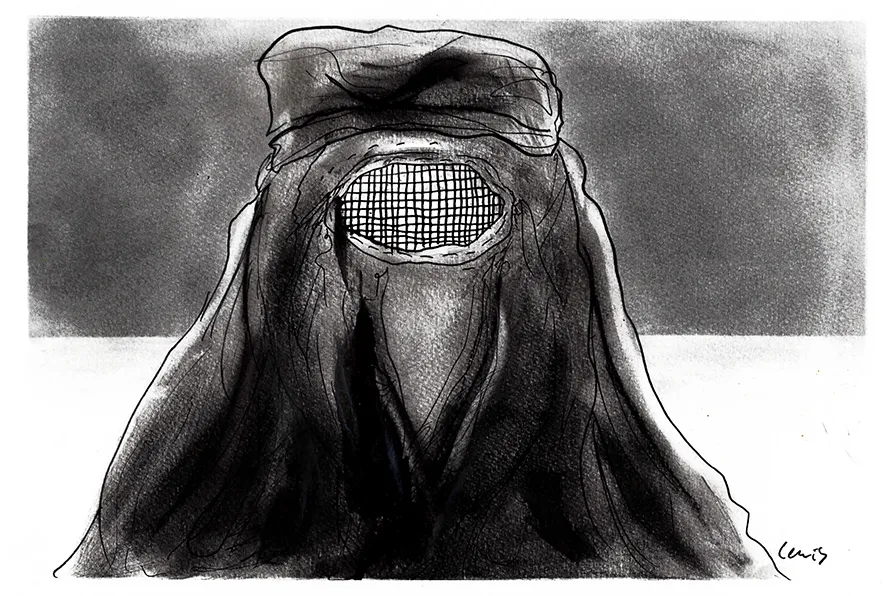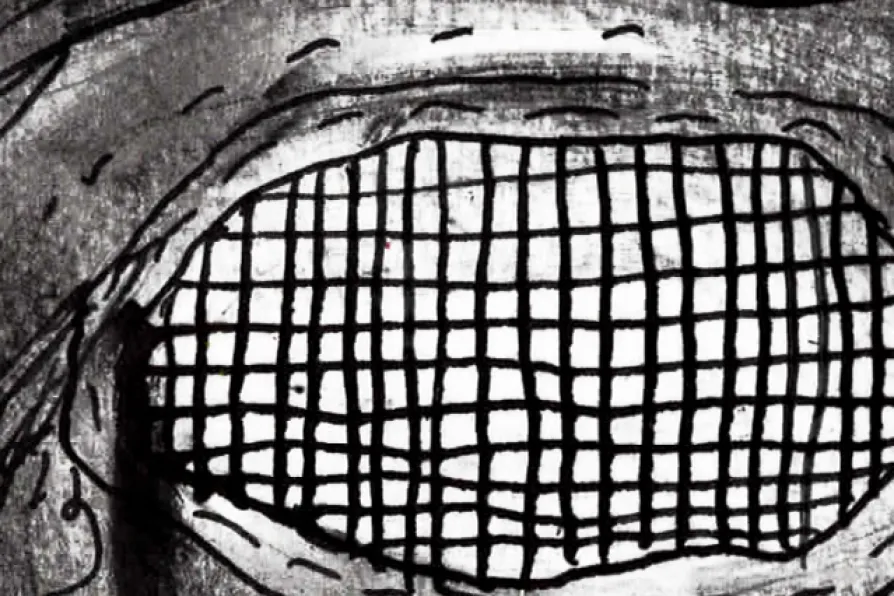JENNY MITCHELL, poetry co-editor for the Morning Star, introduces her priorities, and her first selection
The hard sell of cosmetic surgery creates an authoritarian nightmare. Could resistance to the dream of physical perfection become an act of terrorism?

 Illustration by Lewis Marsden
Illustration by Lewis Marsden
THEY took her in the night; that was the last time I heard my mother’s voice. There was a scream, the smell of panic and sweat, then the sound of scuffling as they ripped the burka off her face. I hid in the cupboard under the bed as I had been drilled to do since a small child. I could hear her shouting as they bundled her out of the house.
The door slammed and I lay quietly in case they returned. My father would be home soon from his night excursions. Once I heard the safety signals that had been drummed into me from a young age: three coughs and a sneeze; I could come out of the cupboard.
It all started with the lips: pumped, glossy, luscious as little ripe cherries. That’s what lips should be like, we were told, and the young ones fell for it so quickly. It was quite a badge of honour: the pout was effortless; it was there when you went to bed and when you got up in the morning.
Then it was the eyebrows next, lifted and taut, it gave the face the alert look, ready for the gaze and the praise. As the months passed by, the information was everywhere: Our Dream Needs You! Scrolling through social media was the best way to access what could be done and what was recommended. There wasn’t too much to think about at first; the face was the thing: tight, taut, smooth, on trend, and achievable for all in just a couple of appointments.
It was so easy. There was no need to take too much time out of busy schedules. You could access all you needed in your local area; you could even combine it with a trip to the supermarket if you lived in the city. The queues outside threaded round the car park and the adjacent streets, while people chatted about the plumping and the filling and shared plans about next steps on the journey to fulfilling The Dream. Local councils were committed to inclusion and so those that lived in small towns or rural areas could visit the mobile vans that parked up weekly.
The older ones couldn’t be catered for quite so easily; they had to go to specialised clinics for surgical procedures. These plush shiny buildings were sprouting up everywhere; and the old certainly had it harder — not just a little prick and the rush of collagen or hyaluronic acid: this was a full catheter in the wrist, potentially life-threatening general anaesthetic and the surgeon’s sleek, silver knife. Whatever needed stretching and pulling, whatever needed to be tightened and stitched was attended to on the operating table.
After the anaesthetic and the throbbing pain had worn off, and weeks later when the bruises, once purple as blackberries had faded, the skin was miraculously tight, taut, slightly surprised. The Dream had drilled us all that was the way a face should look. “No Pain, No Gain” the posters and the adverts gleefully told us; it was worth it to be perfect; to be fully human.
As the years rolled by it was no longer just about the face. For society to fulfil The Dream completely there was much more work to be done. The whole person meant the whole body and so breasts and buttocks were implanted, stomachs were tucked, and any perceived blemish was removed. Big Pharma were everyone’s friend, making The Dream possible with their discount vouchers.
Nobody wanted a petrol voucher, or a two-for-one food deal anymore, it was all about The Dream. We were all in it together and we could only make it happen together. Devizer was the first to launch the Bright Future savings scheme and then the others followed with novel types of incentives, ranging from Ultra Zorbital’s weekly lottery to Grand Star Klass’s loyalty discounts.
The Government sponsored schools to start the Conversion Programme as early as possible. State of the art playing fields and computer rooms were donated to primary schools for allowing the clinic to run weekly workshops and information sessions preparing the children for what was ahead. There was no need to be scared; this was all for the greater good and everyone would benefit.

In the early years, those that resisted were shunned. The stubborn young ones kept what was seen as an irrational hold on their thin lips and could only pout with effort. The old ones had lines on their foreheads, puffy and wrinkled eyes, lines around their mouth, drooping jowls, and double chins. People started to get anxious about seeing them when they were at the shops or queuing for a bus, and children were terrified at the sight of them: something had to be done. The Government acted quickly with the Modesty Bill. Resisters had to cover up if they were in public and, as a gesture of community spirit, local councils issued burkas and balaclavas free of charge and available from all local food banks.
As time passed, the situation became untenable. Fundamentalists had started to turn up at work without their coverings and even the less staunch resistors started to demonstrate against the Bill. Making the Resistance Movement a proscribed terrorist group made little headway towards stamping the madness out. An old woman called Freya who was arrested for revealing her double chin, became a symbol of the movement and gained tremendous support from overseas where The Dream, still in its infancy, was being challenged.
Eventually, the government clamped down. There was no place in schools, universities, workplaces, health centres: in any part of public life or community engagement for these people. So, it became increasingly impossible to live your life in The Dream if you weren’t prepared to be part of it.
Those resisting The Dream risked arrest and imprisonment. My parents were part of the Resistance Movement. Regional solidarity groups were set up to support anyone who refused to submit to the will of The Dream. We were the lucky ones as we had time to create an alternative before the Evacuation Programme passed through Parliament.
The Evacuation Programme was the brainchild of the Home Secretary. After months of planning, a decision was made to send resistors to an offshore colony. It was no use them being a burden to society and most importantly, it was no use letting them be an ugly reminder of the past and the inability of The Dream to be rolled out to everyone. They were shipped to an island about thirty miles off the Scottish mainland and they were given seeds, ploughs, buckets and some livestock.
They were not seen again, until a Government Adviser went out on a visit 20 years later. The Government had given in to pressure, from what were reported as “bleeding heart liberals” overseas, who were concerned for their wellbeing. She reported back on what she saw, and it was sensationalised in news outlets and social media.
The adults had bags under their eyes, double chins, wrinkles and jowls. There were flat-chested women roaming around in even flatter shoes, men with no hair and not a pectoral muscle in sight; but the most shocking was the sight of the children with big ears, crooked teeth and every nose shape under the sun.
Thank goodness, the media reported, that The Dream had rectified that type of abomination in the groundbreaking, Flawless Bill that had passed through Parliament with a thumping majority. It was best that children started with an even playing field and that the procedures that they needed from their teens were simpler and part of a life package. Insurance was only half an annual salary and so there was no worry about meeting your quota. The most committed citizens booked themselves in for procedures on a regular basis and qualified for free lunches whilst in the clinic.
I am a second-generation resistor and have children and grandchildren that know only this life. Our settlements are off-grid and on rugged terrain. We’re pretty sure the authorities know we are here, but as long as we keep away and remain self-sufficient, they show no sign of bothering us.
Word has it that after the Evacuation Project, there was criticism from the United Nations and so the Government decided to turn a blind eye. We are content to be able to look as we are, age naturally and live as we please. Nevertheless, we cannot resist the odd night sojourn with our high-tech holograms and our low-tech paint canisters. Freya’s face looks amazing on every window in the Houses of Parliament and our slogan, “We oppose the Flawless Bill. We support Freedom”, never fails to cause a stir when sprayed all over the walkway of the Millenium Bridge.
Kay Boardman has had articles and poetry published in various journals and anthologies. She lives in Hebden Bridge.
Stories, of up to 1,600 words, should be submitted to: Morningstarshortstories@gmail.com










